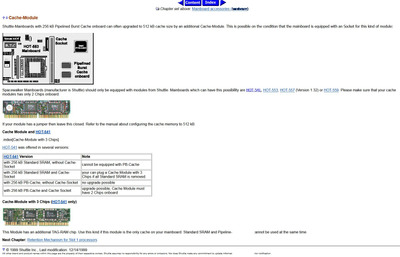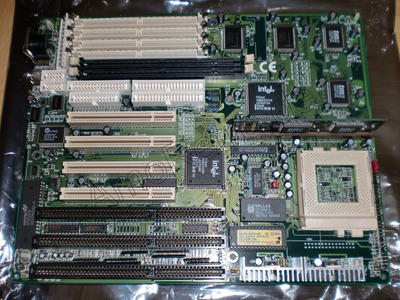Testing completed. Results are not what I thought they would be:
430VX, 133MHz, 256kb onboard L2, ATI Mach64 GT 2B 2MB
32MB RAM:
DOS ONLY:
CACHECHK: L1 cache = 183.7 mb/s, L2 cache = 117.6 mb/s, memory = 77.0 mb/s
SPEEDSYS: L1 cache = 253.90 mb/s, L2 cache = 106.84 mb/s, memory = 75.23 mb/s, bandwidth = 222.07mb/s
3dbench 2.0 = 106.1 fps
WIN95:
QUAKE DEMO = 26.8 FPS
QUAKE 2 DEMO = 11.7 FPS
64MB RAM:
DOS ONLY:
CACHECHK: L1 cache = 183.7 mb/s, L2 cache = 117.6 mb/s, memory = 76.3 mb/s (slightly slower memory)
SPEEDSYS: L1 cache = 253.88 mb/s, L2 cache = 106.84 mb/s, memory = 74.99 mb/s, bandwidth = 221.83mb/s (slightly slower memory)
3dbench 2.0 = 106.1 fps (no change)
WIN95:
QUAKE DEMO = 26.9 FPS (negligibly faster)
QUAKE 2 DEMO = 13 FPS (significantly faster)
So basically everything is almost within measurement error except for quake 2 which was actually faster with 64MB and I'm going to assume this is because after w95 takes its cut, q2 actually runs out of ram to cache stuff and therefore there's a bit of lag with 32MB while it tries to catch up during the timedemo. Just a theory. In any case, maybe I didn't do the right tests but it looks like adding ram only makes the system faster, not slower despite 256kb of L2 not being able to address the entire RAM. Maybe it's addressing the first 32MB of it after all. I just don't see a performance detriment to having 64 and only see a benefit with more demanding games.
Question: Is there a way to toggle write-back vs write-through to see if it's even on the correct setting now? Maybe it was never set to write-back and that's why my testing didn't show improvement with the smaller ram?

